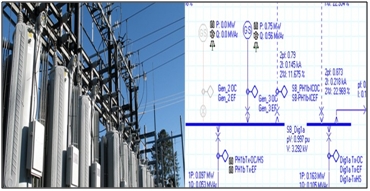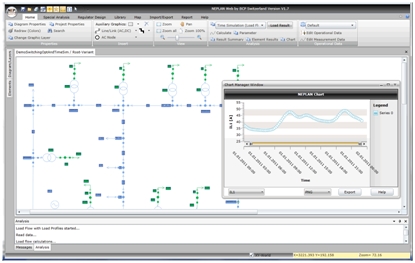Home › Electrical Engineering Forum › General Discussion › Softwares for Power System Analysis
- This topic has 5 replies, 2 voices, and was last updated 10 years, 6 months ago by
Anonymous.
-
AuthorPosts
-
2013/03/13 at 12:20 pm #10870
Steven Mill
ParticipantThe Need
As technological advancements have been made, we are now able to design our experiments in a better manner. One such advancement is the usage of simulation in the case we can’t conduct the practical experiment. Furthermore, it serves as a good feasibility assessment tool. The cost of prototyping and development of certain complex systems is costly. The role of simulation is to mimic the experiment in a virtual model. All major functions and actions are defined through algorithms and mathematical values. In this manner, it is possible to predict the outcomes of a complex experiment via a computer based simulation model. So as the systems increase in size & complexity the need for computer simulations becomes necessity to work efficiently & effectively.
The purpose of writing this post is to introduce Professional Engineers/students with different software that are available for Power System Analysis (PSA). All of the software’s listed below have some unique features that make them different from the other.
Now let’s take a look at some simulation softwares and their usage.
ETAP
Used primarily for power system simulation, the main attributes of this software are:
- Real time data management
- Model design for electrical power systems
- Customizable features
It has a great diversity of users from power consultants to high level designers. The most common software that ETAP offers is ETAP Power Management Software which is developed keeping the needs of the Engineers under consideration. This software aids in better, smart & flexible designs.
ERACS
Designed to simulate electrical power system networks in a rapid manner, ERACS comes as a power system analysis suite. This software combines user friendly interface and complex simulation modeling to cater to the need of safe and punctual operation of the system.
Installing this software can help minimize risk, maintain quality control and increase the overall safety of the system. The main advantage of this software is that it is being constantly updated via feedback from ERA power engineers. The user capacity of ERACS is quite diverse from academic to pure industrial applications.
It also provides its users with multiple program modules. They can be used for options like Harmonic Injection, Impedance, Transient Stability, Protection coordination and network based control/simulation.
Among the Bus bar versions available, the highest one is 1500 and the lowest one is 10. An added feature of this software is the provision of universal dynamic modeler that helps designers & Power Plant Engineers to freely model their governors & AVR’s.
NEPLAN
Seen as a major advancement in simulation softwares, NEPAN 360 is a browser integrated analysis tool. Through this users can make use of cloud computing, dramatically increasing its usability. This means that it is possible to use it anywhere without installing it on system. For diversity, both cloud and non-cloud versions are available.
A major advantage that this software has over others is that it integrated geographical knowledge as well. It is now being prominently used in smart grids and renewable energy models. Through the geographical integration, it is possible to improve the visualization. The technical term for this model is Geographical Information Systems (GIS).
As far as calculation modules are concerned, the cloud and desktop version of NEPLAN have similar efficacy. Their model of control over symmetrical and asymmetrical power networks is synonymous. A number of parameters have been included in the module for efficient functioning. The major ones include: load flow, energy loss, short circuit, risk assessment, motor starting, express feeder and pole strength. In terms of analysis we have: harmonic, investment, reliability, thermal and grounding design.
It is quite apparent from the detail that has been provided above that NEPLAN is entirety based software that brings in a number of parameter for accurate calculation for the power systems.
Kalkitech PowerApps
The main attributes of this power system engineering software include:
- Analytical tool for transmission, distribution and industrial power systems
- Customized IT support of operational analysis in power engineering systems
- Client services for training (integration and comprehension)
DAPPER
The software is developed by SKM Systems Analysis, Inc. a California-based company. This software has integrated modules and takes into account the three phase power system design. Many of the calculations included in the module are similar to those that have been described in NEPLAN above. In addition to this it also has voltage drop calculations; transformer sizing that provides effective simulations for complex designs.
One of the core competences of DAPPER is that it is able to generate better and detailed simulations using comparative analysis in real time. Each function that is fed in the software is in a problem solving oriented manner. The stability of this software is better on the account that it accesses the standard design libraries for usage. The communications designs are effectively designed for real time feedback such as reporting. It also adds to the design safety of the system in the sense that it does a quick analysis of short circuit calculations & compares the results with actual calculations.
Another application of DAPPER is in the case of ill conditioned systems where it uses elements like double precision sparse matrix solution for accurate results. Such usage becomes important in the case of transformer load where voltage drop and the loss analysis can be monitored in a better manner.
Conclusion
With the description of different simulation softwares, some main attributes have been discussed. Furthermore, it is quite evident that the usage of such simulations has become necessary. Not only it saves cost for development for prototype but also increases the feasibility of the project. With better understanding of the electrical systems, more complex simulations can be run.
Have you ever used one of these softwares?
2013/03/15 at 2:11 pm #13127Anonymous
GuestA very nice article. It was very informative but one thing i did not know is in what conditions each software is used. How do these softwares distinguish each other from applications point of view? Are all these softwares good for all application?
I heard of Etap. Its been the leading industry in providing power software solutions but are their competitors good enough?
From a student point of view which software must i go for?
Thank
2013/03/28 at 7:31 am #13008Anonymous
GuestGood questions from Jeff Williams above. Moreover I would like to ask if anyone of the above-mentioned software packages are suitable for the simulation (in real time) of low voltage installations like large buildings or industries in order to examine the load flow, the electrical energy consumption, the various phenomena (especially in non linear loads ), the cable sizes, drop voltage etc. I m interested in a real time electrical simulation and analysis software for the low voltage side.
2013/04/09 at 8:06 pm #13029Anonymous
GuestPuede alguien por favor darme referencias sobre la utilidad del software SKM Power Tools for Windows para realizar análisis y dimensionamiento de sistemas de distribución en media y baja tension?
Actualmente lo utilizo para estudios de Arc Flash y diseño de electrodos de puesta a tierra.
Hago esta consulta dado que estoy evaluando la posibilidad de adquirir los módulos de este software para realizar dichos análisis y dimensionamientos.Muchas gracias
2013/04/15 at 10:01 pm #12824Anonymous
Guesti will be very happy if some of the software can be sent to my website.
2014/08/13 at 6:55 pm #13518Anonymous
GuestThanks for this information . how can I upload it?
-
AuthorPosts
- You must be logged in to reply to this topic.



